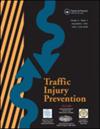Estimation and modeling of pedestrian dilemma zone at uncontrolled intersections under mixed traffic conditions
IF 1.6
3区 工程技术
Q3 PUBLIC, ENVIRONMENTAL & OCCUPATIONAL HEALTH
引用次数: 0
Abstract
Objectives
Pedestrian gap acceptance (PGA) theory is the basic concept for pedestrian dilemma zone (PDZ) analysis and modeling and their gap acceptance behavior depends on dilemma behavior also. Uncontrolled intersections are one of the major locations where pedestrians have more dilemma and there is a possibility of an interaction between the pedestrian and vehicle due to the incorrect decision taken by the pedestrian when the vehicle lies within the limits of PDZ. Elimination and modeling of spatial boundaries of pedestrian dilemma stage improve the PGA.
Methods
The present study is intended to quantify and model the pedestrian dilemma zone (PDZ) boundaries at uncontrolled X-intersections under mixed traffic conditions. Video data were collected from four four-legged uncontrolled intersections in India. Pedestrian and vehicle information was extracted using DataFromSky software and manually from video. The Cumulative Gap Distribution (GCD) and Support Vector Machine (SVM) methods were used to estimate the boundaries of PDZ and developed a binary logistic regression model to estimate the PDZ boundary limits.
Results
The lower boundary limits of PDZ using GCD and SVM methods are 9.0 m and 6.0, respectively, and the upper boundary limits of PDZ using GCD and SVM methods are 16.5 and 18.5 m, respectively. The GCD method overestimated the lower limit and underestimated the upper limit compared with the SVM method. The binary logistic regression model results confirmed that pedestrian age, gender and crossing speed have a negative correlation and location of pedestrian crossing, vehicle type, and approaching speed have a positive correlation with the boundary limits of PDZ.
Conclusions
From the present study, it is concluded that SVM better estimated the PDZ boundary limits with the largest margin compared to the GCD method. It is concluded that the boundary limits shift away from the intersection in the case of female and old-age pedestrians compared to male and young-age pedestrians, respectively. The size benefit in the case of 2Ws is the reason for shifting the PDZ boundary limits close to the crosswalk. The lower approaching speeds of the vehicles at uncontrolled intersections are the reason for pedestrians accept the gap at shorter distances.
混合交通条件下无控制交叉路口行人困境区的估算和建模。
目的:行人间隙接受(PGA)理论是行人两难区(PDZ)分析和建模的基本概念,行人的间隙接受行为也取决于两难行为。不受控制的交叉路口是行人进退两难的主要地点之一,当车辆位于行人进退两难区内时,行人可能会做出错误的决定,从而导致行人与车辆之间的相互作用。消除行人进退两难阶段的空间边界并建立模型可改善 PGA:本研究旨在对混合交通条件下非受控 X 型交叉路口的行人两难区(PDZ)边界进行量化和建模。视频数据来自印度的四个四条腿无控制交叉路口。使用 DataFromSky 软件和人工从视频中提取行人和车辆信息。使用累积间隙分布(GCD)和支持向量机(SVM)方法来估计 PDZ 的边界,并开发了一个二元逻辑回归模型来估计 PDZ 的边界限制:采用 GCD 和 SVM 方法估算的 PDZ 边界下限分别为 9.0 米和 6.0 米,采用 GCD 和 SVM 方法估算的 PDZ 边界上限分别为 16.5 米和 18.5 米。与 SVM 方法相比,GCD 方法高估了下限,低估了上限。二元逻辑回归模型结果证实,行人年龄、性别和过街速度与 PDZ 的边界限制呈负相关,而行人过街地点、车辆类型和接近速度与 PDZ 的边界限制呈正相关:本研究得出的结论是,与 GCD 方法相比,SVM 更好地估算了 PDZ 边界限制,且余量最大。结论是,与男性和年轻行人相比,女性和老年行人的边界限制分别偏离了交叉路口。2Ws 的尺寸优势是将人行横道分隔带边界限制移近人行横道的原因。在不受控制的交叉路口,车辆的接近速度较低,这也是行人在较短距离内接受空隙的原因。
本文章由计算机程序翻译,如有差异,请以英文原文为准。
求助全文
约1分钟内获得全文
求助全文
来源期刊

Traffic Injury Prevention
PUBLIC, ENVIRONMENTAL & OCCUPATIONAL HEALTH-
CiteScore
3.60
自引率
10.00%
发文量
137
审稿时长
3 months
期刊介绍:
The purpose of Traffic Injury Prevention is to bridge the disciplines of medicine, engineering, public health and traffic safety in order to foster the science of traffic injury prevention. The archival journal focuses on research, interventions and evaluations within the areas of traffic safety, crash causation, injury prevention and treatment.
General topics within the journal''s scope are driver behavior, road infrastructure, emerging crash avoidance technologies, crash and injury epidemiology, alcohol and drugs, impact injury biomechanics, vehicle crashworthiness, occupant restraints, pedestrian safety, evaluation of interventions, economic consequences and emergency and clinical care with specific application to traffic injury prevention. The journal includes full length papers, review articles, case studies, brief technical notes and commentaries.
 求助内容:
求助内容: 应助结果提醒方式:
应助结果提醒方式:


